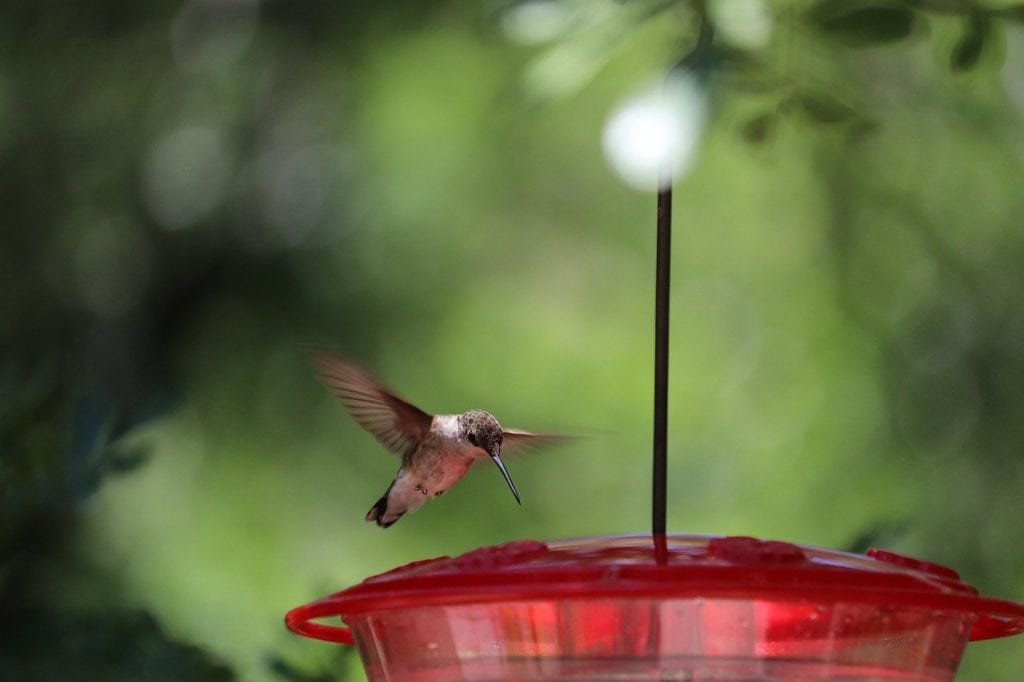How Far Apart Should Hummingbird Feeders Be?
Last Updated on

Feeding the birds has been a human tradition for quite some time, but different birds have different nutritional and physical needs. Hummingbird feeders are unique in that they dispense other food from a traditional bird feeder. But can you have too many hummingbird feeders? Can that be detrimental to the birds? Here’s what some experienced birders have to say on the subject!

Distance Between Feeders
Experts recommend putting at least 15 feet between hummingbird feeders. While it might be tempting to group all your hummingbird feeders into a cluster to make one large feeding station, experts warn that one aggressive hummingbird may take over such a station. A larger hummingbird may keep smaller, more timid hummers from enjoying your generosity.
Keeping the distance between the feeders is even better if they are out of sight of each other. Placing the feeders around a corner or around a large tree that can conceal feeding activity will further protect the birds and encourage them to visit.
Hummingbirds often fight around feeders, unlike songbirds who feed together peacefully, so a hummer might become a bit too possessive if it can see other birds at the feeders.

How Many Feeders Should I Put Out?
At least three feeders, appropriately distanced from each other, will give you the best chance at helping the local hummingbirds. As previously mentioned, hummingbirds will fight each other at food sources so having multiple feeders means that numerous birds can feed at one time.
Hummingbirds aren’t very large; so, several smaller feeders will do better by the population than one colossal feeder. Be aware that animals other than hummingbirds will find and utilize the feeders as well. This sharing is normal and healthy for the ecosystem. You need not scare the animals away.
The Impact of Feeders on the Environment
More than just worrying about the birds’ safety, people looking to place hummingbird feeders should know how many they’re placing since they can hurt the environment.
Artificial feeders can provide excellent alternatives to nectar for hummingbirds, and the placement of feeders generally increases the local population. However, too many of them can cause the birds to stop visiting flowers and change the distribution of local flora.
A case study from Arizona showed that hummingbird feeders represented about 59% of hummingbird visits, and the presence of feeders was negatively correlated with the abundance of local flora. The birds will generally go for the more abundant and more accessible to obtain feeder foods rather than pollinating the local flora, which can be detrimental to the local ecosystem.
A study done in Costa Rica showed that permanent hummingbird feeders had a “competitive and antagonistic” relationship with flowers. The study suggests that while the exact relationship between feeders and behavior is unknown, the permanent presence of feeders could alter hummingbird migration routes as they present an abundant food source during a season where flowers are less abundant.
This study found that many hummingbirds will travel further to feeders during seasons when flower growth was less abundant, but that feeder use decreased during seasons where flower growth flourished.
Feeders also have different bacterial compositions from flower nectar. A study showed that while the bacterial compositions don’t generally cause illnesses, it’s unclear how this change in microbiology affects the hummingbirds themselves. Ingesting different bacteria can cause a change in a creature’s gut flora and impact their gastrointestinal function, even if it doesn’t make them immediately ill.
Hummingbird feeders also introduce species that may not be as common to the area. One study found that long-nosed bats would travel very long distances to visit permanent hummingbird feeders. This attraction could extend to other species which may visit these feeders, and their presence or overabundance may affect the local ecosystem.

Does This Mean Hummingbird Feeders Are Bad?
Not at all! Hummingbird feeders are suitable for the birds and are correlated with a larger population of hummingbirds. Aspiring birdwatchers should just be aware of putting too many out. Too many feeders can present an easy food source that can cause the birds to stop pollinating flowers properly! However, a few feeders won’t destroy the local plant life.
Related Read: How to Keep Squirrels Out of Hummingbird Feeders

In Conclusion
Hummingbird feeders are a tempting fixture for those who want to watch these beautiful birds buzz around their yards. They also provide an excellent food source for the birds when the floral growth isn’t enough to sustain them. Placing feeders is a great way to help the local hummingbird populations while giving you a little treat to watch out your window in the afternoons!
You might also be interested in:
- 10 Proven Ways to Attract Hummingbirds to Your Yard & Feeders
- 10 Proven Ways to Keep Bees OUT of Hummingbird Feeders
Featured Image Credit: Pixabay
About the Author Robert Sparks
Robert’s obsession with all things optical started early in life, when his optician father would bring home prototypes for Robert to play with. Nowadays, Robert is dedicated to helping others find the right optics for their needs. His hobbies include astronomy, astrophysics, and model building. Originally from Newark, NJ, he resides in Santa Fe, New Mexico, where the nighttime skies are filled with glittering stars.
Related Articles:
How to Clean a Refractor Telescope: Step-by-Step Guide
How to Clean a Telescope Eyepiece: Step-by-Step Guide
How to Clean a Rifle Scope: 8 Expert Tips
Monocular vs Telescope: Differences Explained (With Pictures)
What Is a Monocular Used For? 8 Common Functions
How to Clean a Telescope Mirror: 8 Expert Tips
Brightfield vs Phase Contrast Microscopy: The Differences Explained
SkyCamHD Drone Review: Pros, Cons, FAQ, & Verdict
